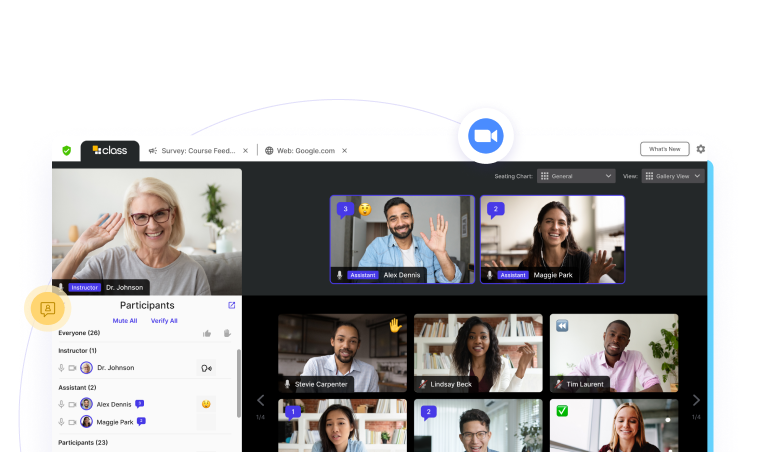
Matt is a passionate EdTech leader with 16 years of experience driving innovation in higher education. His commitment to enhancing student success and engagement, both on campus and online, is inspiring. Known for his contagious enthusiasm, Matt connects strategy with impactful outcomes.

Matt is a passionate EdTech leader with 16 years of experience driving innovation in higher education. His commitment to enhancing student success and engagement, both on campus and online, is inspiring. Known for his contagious enthusiasm, Matt connects strategy with impactful outcomes.

The workforce is undergoing a massive transformation. Rapid advancements in technology, shifting market demands, and the evolving nature of work are pushing millions of professionals to upskill, reskill, or transition into new careers. At the same time, younger adults entering the workforce for the first time also require training to meet the demands of today’s job market.
Colleges and universities are uniquely positioned to respond to this retraining revolution by implementing virtual learning programs. Offering virtual, accessible workforce retraining programs allows institutions to rapidly respond to both market and learner demands, including flexibility around work commitments and family responsibilities. The U.S. online education industry is already valued at $100 billion and is projected to grow to $687 billion by 2030, signaling robust demand for scalable virtual options. Virtual programs empower colleges and universities to modernize and scale their instruction, equipping a broader audience with up-to-date skills that can revolutionize their career opportunities.
Designing a successful online workforce retraining program requires more than just digitizing existing courses. To be truly effective, programs need to be structured around industry needs, engaging for learners, and supporting the entire student holistically.
One of the most critical components of any workforce retraining program is ensuring that it prepares students for real job opportunities. Colleges must start by conducting labor market research to identify in-demand skills and growing industries. This means analyzing employment trends, engaging with local and national workforce boards, and seeking input from industry leaders to shape curriculum development.
Partnerships with employers are especially valuable. By collaborating with companies, institutions can tailor courses to meet current workforce needs, ensuring graduates have the skills employers are actively seeking. Some universities have successfully implemented co-designed curricula, where businesses play a direct role in shaping course content and providing input on skill gaps within their industries. Others have developed microcredential programs that align with specific job roles, allowing learners to earn targeted certifications that enhance their employability without requiring a full degree program. In some fields like IT, these microcredentials can lead to wage increases of up to $20,000, significantly boosting employability. Hiring managers are increasingly recognizing the value of non-degree credentials—74% have noted a rise in job seekers listing them on their resumes, making them a valuable asset in workforce retraining strategies.
Simply putting content online isn’t enough—engagement is key. Virtual workforce retraining programs must offer interactive, hands-on learning experiences to keep students motivated and ensure knowledge retention.
Live virtual classrooms provide an opportunity to create meaningful interactions between instructors and learners. Features like enhanced breakout rooms, real-time discussions, and collaborative whiteboarding help replicate the engagement of an in-person class. These elements are particularly important for skills-based training, where active participation enhances understanding.
Beyond live sessions, institutions should incorporate practical learning opportunities into their programs. This could include virtual labs for technical fields, simulation exercises for industries like healthcare or manufacturing, or project-based assignments that mirror real-world tasks. Instructors can also use scenario-based learning to help students apply their knowledge in job-relevant situations. The key is to design courses that go beyond passive consumption of information and instead encourage active skill development and mastery.
Many students who pursue retraining face additional challenges beyond learning course material. They may be navigating a career change, balancing family responsibilities, or returning to education after years away from a formal learning environment. Colleges must take a holistic approach to student support to improve retention and success rates.
Advising and career coaching should be integrated into virtual retraining programs. Personalized guidance helps students understand how to apply their new skills in the job market, build resumes that reflect their training, and prepare for interviews. Some institutions have found success by pairing learners with mentors—either faculty members or industry professionals—who can provide insight into career pathways and help build professional networks.
Additionally, colleges need to ensure that students have the necessary digital literacy skills to succeed in an online learning environment. While many adult learners are comfortable with technology, others may need support in navigating virtual classrooms, submitting assignments online, or using collaboration tools. In fact, over 16% of adults in the United States are considered digitally illiterate. Offering onboarding modules or ongoing tech support can help eliminate these barriers and improve the learning experience.
For institutions looking to expand their workforce retraining offerings through virtual learning, the first step is assessing their existing programs and identifying opportunities for growth. This requires evaluating current course offerings, analyzing labor market needs, and discussing alignment with industry partners.
Investing in the right technology is also crucial. A purpose-built virtual classroom platform offers features that go beyond basic video conferencing, enabling interactive, engaging learning experiences. Learning management systems (LMS) should be integrated with these live instruction tools to create a seamless learning environment where students can easily access materials, track progress, and interact with instructors and peers.
Finally, institutions must prioritize measuring outcomes. Workforce retraining programs should be designed with clear metrics in mind, such as job placement rates, skill acquisition benchmarks, and student satisfaction levels. Collecting and analyzing this data allows colleges to refine their programs, address gaps, and continuously improve the learning experience.
Colleges and universities have a unique opportunity to play a leading role in the workforce retraining revolution with virtual learning programs in place. Virtual learning is a powerful tool for expanding access, delivering industry-aligned training, and equipping learners with the skills they need to succeed in an evolving job market.
Institutions that embrace this model will be better positioned to serve lifelong learners, support economic mobility, and build stronger partnerships with employers. By designing programs that are engaging, flexible, and directly tied to workforce needs, colleges can not only help individuals transition into new careers but also strengthen the broader economy.
Now is the time for higher education leaders to think strategically about their role in workforce retraining. By leveraging virtual learning, institutions can drive meaningful impact and open doors for learners who need it most.
Ready to expand your workforce retraining programs? Connect with a Class expert today to learn how our virtual classroom solution can help you reach more learners with engaging, flexible programs that lead to successful careers.

Matt is a passionate EdTech leader with 16 years of experience driving innovation in higher education. His commitment to enhancing student success and engagement, both on campus and online, is inspiring. Known for his contagious enthusiasm, Matt connects strategy with impactful outcomes.

Matt is a passionate EdTech leader with 16 years of experience driving innovation in higher education. His commitment to enhancing student success and engagement, both on campus and online, is inspiring. Known for his contagious enthusiasm, Matt connects strategy with impactful outcomes.
Get our insights, tips, and best practices delivered to your inbox

Sign up for a product demo today to learn how Class’s virtual classroom powers digital transformation at your organization.

Features
Products
Integrations